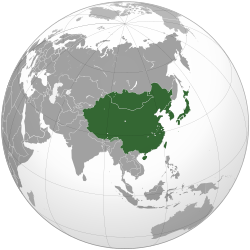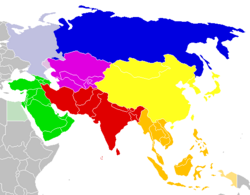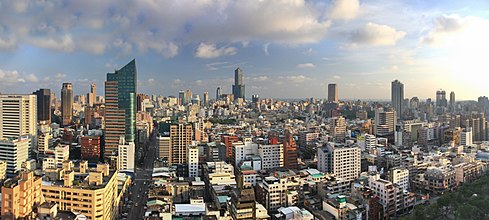This is an old revision of this page, as edited by 180.194.222.197 (talk) at 10:15, 25 November 2021 (Revert Edits). The present address (URL) is a permanent link to this revision, which may differ significantly from the current revision.
Revision as of 10:15, 25 November 2021 by 180.194.222.197 (talk) (Revert Edits)(diff) ← Previous revision | Latest revision (diff) | Newer revision → (diff) For other uses, see East Asia (disambiguation). Place| East Asia | |
|---|---|
 | |
| States and territories | |
| Capital cities | |
| Other major cities | List |
| Area | |
| • Total | 11,839,074 km (4,571,092 sq mi) |
| Population | |
| • Total | 1,575,784,500 |
| • Density | 130/km (340/sq mi) |
| Time zone |
|
| Languages and language families | |
Template:Contains Chinese text Template:Contains Japanese text Template:Contains Korean text
| East Asia | |||||||||||||||||||||||||||||
|---|---|---|---|---|---|---|---|---|---|---|---|---|---|---|---|---|---|---|---|---|---|---|---|---|---|---|---|---|---|
| Chinese name | |||||||||||||||||||||||||||||
| Traditional Chinese | 東亞/東亞細亞 | ||||||||||||||||||||||||||||
| Simplified Chinese | 东亚/东亚细亚 | ||||||||||||||||||||||||||||
| |||||||||||||||||||||||||||||
| Vietnamese name | |||||||||||||||||||||||||||||
| Vietnamese alphabet | Đông Á | ||||||||||||||||||||||||||||
| Korean name | |||||||||||||||||||||||||||||
| Hangul | 동아시아/동아세아/동아 | ||||||||||||||||||||||||||||
| Hanja | 東아시아/東亞細亞/東亞 | ||||||||||||||||||||||||||||
| |||||||||||||||||||||||||||||
| Mongolian name | |||||||||||||||||||||||||||||
| Mongolian Cyrillic | Зүүн Ази ᠵᠡᠭᠦᠨ ᠠᠽᠢ | ||||||||||||||||||||||||||||
| Japanese name | |||||||||||||||||||||||||||||
| Kanji | 東亜細亜(東アジア)/東亜 | ||||||||||||||||||||||||||||
| Kana | ひがしアジア/とうあ | ||||||||||||||||||||||||||||
| Kyūjitai | 東亞細亞/東亞 | ||||||||||||||||||||||||||||
| |||||||||||||||||||||||||||||
| Russian name | |||||||||||||||||||||||||||||
| Russian | Восточная Азия | ||||||||||||||||||||||||||||
| Romanization | Vostochnaja Azija | ||||||||||||||||||||||||||||
East Asia or Eastern Asia is the eastern subregion of the Asian continent, which can be defined in either geographical or cultural terms. Geographically and geopolitically, it covers about 12,000,000 km (4,600,000 sq mi), or about 28% of the Asian continent, about 15% bigger than the area of Europe.
More than 1.5 billion people, about 38% of the population of Asia and 22% or over one fifth of all the people in the world, live in East Asia. The region is one of the world's most populated places, with a population density of 133 inhabitants per square kilometre (340/sq mi), being about three times the world average of 45/km (120/sq mi), although Mongolia has the lowest population density of a sovereign state. Using the UN subregion definitions, East Asia ranks second in population only to Southern Asia.
Historically, many societies in East Asia have been part of the Chinese cultural sphere, and East Asian vocabulary and scripts are often derived from Classical Chinese and Chinese script. Sometimes Northeast Asia is used to denote Japan and Korea. Major religions include Buddhism (mostly Mahayana), Confucianism or Neo-Confucianism, Taoism, Chinese folk religion in China and Taiwan, Shinto in Japan, Shamanism in Korea, Mongolia and other indigenous populations of northern East Asia, and recently Christianity in South Korea. The Chinese Calendar is the root from which many other East Asian calendars are derived.
History
Main article: History of East AsiaThe history of East Asia is predominantly the history of the Chinese Dynasties that dominated the region in matters of trade as well as militarily, such as the Qin and the Han Dynasties. There are records of tributes sent overseas from the early kingdoms of Korea and Japan. There were also considerable levels of cultural and religious exchange between the Chinese and other regional Dynasties and Kingdoms.
As connections began to strengthen with the Western world, China's power began to diminish. Around the same time, Japan solidified itself as a nation state. Throughout WWII, North Korea, South Korea, Taiwan and Eastern China fell under Japanese control. Following Japan's defeat in the war, the Korean peninsula became independent, while Taiwan became part of the Republic of China.
Uses of the term East Asia

The UNSD definition of Eastern Asia purely based on statistical conveniece, but also other common definitions of East Asia contain the entirety of China, Japan, North Korea, South Korea, Mongolia and Taiwan.
Culturally, China, Japan, Korea, Taiwan, and Vietnam are commonly seen as being encompassed by cultural East Asia.
Alternative definitions
There are mixed debates around the world whether these countries or regions should be considered in East Asia or not.
- Vietnam (officially part of Southeast Asia geographically, although culturally it is a part of the East Asian cultural sphere, politically, it is related to both Southeast Asia and East Asia)
- Siberia in Russia (often described as North Asia due to its location, although this part of Russia is often seen as more closely related to its East Asian neighbours)
- Outer Manchuria in Russia (also known as Priamurye) - this part of Russia was ruled by the Chinese Qing dynasty until the Treaty of Aigun in 1858 and the Treaty of Peking in 1860, when the Sino-Russian border was realigned on the Amur and Ussuri rivers in Russia's favour. In contrast to Siberia it has a humid continental climate.
- Sovereignty issues exist over some territories in the South China Sea. Hong Kong, Macau, and Taiwan, the three disputed regions or states claimed by China, are considered as part of the Southeast Asia in some occasions, especially by the local people.
- For the purposes of recording plant distributions, the World Geographical Scheme for Recording Plant Distributions uses a much smaller area, consisting only of Japan, Korea and Taiwan, plus some associated islands.
In business and economics, East Asia has been used to refer to a wide geographical area covering ten countries in ASEAN, People's Republic of China, Japan, South Korea, and Taiwan. However, in this context, the term "Far East" is often more appropriate which covers ASEAN countries and the traditional countries in East Asia. Far East describes the region's geographical position in relation to Europe rather than its location within Asia. Alternatively, the term "Asia Pacific Region" is often used in describing the Far East region as well as Oceania.
In contrast to the United Nations definition, East Asia commonly is used to refer to the eastern part of Asia, as the term implies. Observers preferring a broader definition of 'East Asia' often use the term Northeast Asia to refer to the greater China area, the Korean Peninsula, Taiwan, and Japan, with Southeast Asia covering the ten ASEAN countries. This usage, which is increasingly widespread in economic and diplomatic discussion, is at odds with the historical meanings of both "East Asia" and "Northeast Asia". The Council on Foreign Relations defines Northeast Asia as Japan and Korea.
Territory and region data
Demographics
See also: Ethnic groups of East Asia| Country | Area km² | Population | Population density per km² |
HDI (2014) | Capital |
|---|---|---|---|---|---|
| 9,640,011 | 1,339,724,852 | 138 | 0.719 | Beijing | |
| 1,104 | 7,061,200 | 6,390 | 0.891 | Hong Kong | |
| 377,930 | 127,950,000 | 337 | 0.890 | Tokyo | |
| 30 | 556,800 | 18,662 | 0.868 (2012) | Macau | |
| 1,564,100 | 2,809,600 | 2 | 0.698 | Ulaanbaatar | |
| 120,538 | 24,346,000 | 198 | N/A | Pyongyang | |
| 100,210 | 51,115,702 | 500 | 0.891 | Seoul | |
| 36,188 | 23,174,528 | 639 | 0.882 (2014) | Taipei |
Economy
Main article: Economy of East Asia| Country | GDP nominal millions of USD (2013) |
GDP nominal per capita USD (2014)
|
GDP PPP millions of USD (2013) |
GDP PPP per capita USD (2013) |
|---|---|---|---|---|
| 9,240,270 | 7,589 | 16,157,703 | 11,850 | |
| 274,012 | 39,871 | 382,396 | 54,260 | |
| 4,901,529 | 36,332 | 4,624,359 | 37,630 | |
| 51,753 | 91,376 | 80,744 | 142,599 | |
| 10,258 | 4,096 | 26,779 | 8,810 | |
| 11,516 | 583 | 40,000 | 1,800 | |
| 1,304,553 | 28,101 | 1,664,258 | 33,440 | |
| 503,688 | 22,598 | 926,062 | 38,749 |
Culture
Main article: East Asian cultural sphereThe culture of East Asia has been influenced by the civilization of northern China. East Asia shares a Confucian ethical philosophy, Buddhism, political and legal structures, and historically a common writing system. The relationship between Northern China and East Asia has been compared to the historical influence of Greco-Roman civilization on Europe.
Cities
Main article: Cities of East Asia-
 Tokyo is the largest city in the world, both in metropolitan population and economy.
Tokyo is the largest city in the world, both in metropolitan population and economy.
-
 Seoul is the capital and largest city of South Korea (ROK), and is a leading global technology hub.
Seoul is the capital and largest city of South Korea (ROK), and is a leading global technology hub.
-
 Kaohsiung is the second largest city in Taiwan. Kaohsiung Harbor is one of the largest harbors in the world.
Kaohsiung is the second largest city in Taiwan. Kaohsiung Harbor is one of the largest harbors in the world.
-
 Shanghai is the largest city in China and one of the largest in the world, and is the leading commercial and financial center of mainland China.
Shanghai is the largest city in China and one of the largest in the world, and is the leading commercial and financial center of mainland China.
-
 Taipei is the capital of the Taiwan and is one of the world's leading technical centres in Asia, and is the location of the Taipei 101. Night View of Taipei
Taipei is the capital of the Taiwan and is one of the world's leading technical centres in Asia, and is the location of the Taipei 101. Night View of Taipei
-
 Hong Kong, enclosed by the Pearl River Delta and South China Sea, is one of the world's leading global financial centres and is known for its cosmopolitan lifestyle.
Hong Kong, enclosed by the Pearl River Delta and South China Sea, is one of the world's leading global financial centres and is known for its cosmopolitan lifestyle.
-
 Ulaanbaatar is the largest city in Mongolia with a population of 1 Million as of 2008.
Ulaanbaatar is the largest city in Mongolia with a population of 1 Million as of 2008.
See also
- East Asia Summit
- East Asian Community
- East Asian cultural sphere
- East Asian Games
- East Asian languages
- East Asian studies
- Four Asian Tigers
- China–Japan–South Korea trilateral summit
- Chinese calligraphy
- Japanese calligraphy
- Korean calligraphy
- Mongolian calligraphy
Notes
- The area figure is based on the combined areas of China (including Hong Kong, Macau, Aksai Chin, and Trans-Karakoram Tract), Japan, North Korea, South Korea, Taiwan, and Vietnam as listed at List of countries and outlying territories by total area.
- The population figure is the combined populations of China (Mainland China, Hong Kong, Macau), Japan , North Korea, South Korea, and Taiwan as listed at List of countries by population (last updated Feb 22, 2011).
- ^ Taiwan (officially the Republic of China) has limited recognition internationally as a sovereign state while most democratic countries keeps quasi-official relations with her, see Political status of Taiwan.
References
- ^ "East Asia". encarta. Microsoft. Archived from the original on 2009-10-31. Retrieved 2008-01-12.
the countries, territories, and regions of China, Mongolia, Hong Kong, Japan, North Korea, South Korea, Macau, and Taiwan.
{{cite web}}: Unknown parameter|deadurl=ignored (|url-status=suggested) (help) - ^ Columbia University - "East Asian cultural sphere" "The East Asian cultural sphere evolves when Japan, Korea, and what is today Vietnam all share adapted elements of Chinese civilization of this period (that of the Tang dynasty), in particular Buddhism, Confucian social and political values, and literary Chinese and its writing system."
- ^ "Northeast Asia." Council on Foreign Relations. Retrieved on August 10, 2009.
- Chongho Kim, "Korean Shamanism", 2003 Ashgate Publishing
- Andreas Anangguru Yewangoe, "Theologia crucis in Asia", 1987 Rodopi
- "Background Note: South Korea". State. U.S. Department of State. Retrieved 2000-04-27.
{{cite web}}: Check date values in:|accessdate=(help) - "United Nations Statistics Division- Standard Country and Area Codes Classifications (M49)". United Nations Statistics Division. 6 May 2015. Retrieved 2010-07-24.
- "United Nations Statistics Division- Standard Country and Area Codes Classifications (M49)". United Nations Statistics Division. 6 May 2015. Retrieved 2010-07-24.
- "Composition of macro geographical (continental) regions, geographical sub-regions, and selected economic and other groupings". United Nations Statistics Division. 11 February 2013. Retrieved 28 May 2013.
- R. Keith Schopper's East Asia: Identities and Change in the Modern World
- Joshua A. Fogel (UC Santa Barbara/University of Indiana) Nationalism, the Rise of the Vernacular, and the Conceptualization of Modernization in East Asian Comparative Perspective
- United Nations Environment Programme (mentions sinosphere countries) Approaches to Solution of Eutrophication
- 香港是東南亞結腸腫瘤最高發區, Chinese University of Hong Kong
- CIA The World Factbook-Hong Kong
- CIA The World Factbook-Macau
- CIA The World Factbook-Taiwan
- Christopher M. Dent (2008). East Asian regionalism. London: Routledge. pp. 1–8.
- Charles Harvie, Fukunari Kimura, and Hyun-Hoon Lee (2005), New East Asian regionalism. Cheltenham and Northamton: Edward Elgar, pp.3-6.
- Peter J. Katzenstein and Takashi Shiraishi (2006), Beyond Japan: the dynamics of East Asian regionalism. Ithaca: Cornell University Press, pp.1-33
- http://data.worldbank.org/indicator/NY.GDP.MKTP.CD
- http://www.imf.org/external/pubs/ft/weo/2015/01/weodata/index.aspx
- Macau(2013)
- http://data.worldbank.org/indicator/NY.GDP.MKTP.PP.CD
- http://data.worldbank.org/indicator/NY.GNP.PCAP.PP.CD
- ^ Edwin O. Reischauer, "The Sinic World in Perspective," Foreign Affairs 52.2 (January 1974): 341-348. JSTOR
